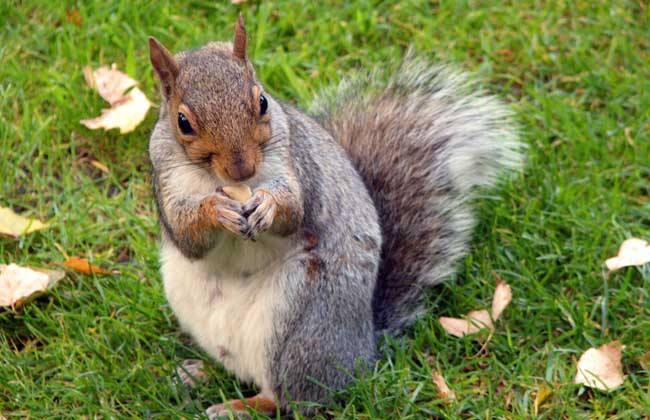(单词翻译:单击)
听力文本
This is Scientific American — 60-Second Science. I'm Steve Mirsky.
We humans sometimes use a memory technique called chunking. For example, with phone numbers we usually remember the three-digit chunk and the four-digit chunk. Two items instead of seven.
"Well, the way I think about chunking is it's any shortcutting strategy or mnemonic device that would allow an animal, be it human or otherwise, to increase their memory capacity and improve recall." Mikel Delgado, an animal behaviorist now at U.C. Davis.
"And so in the case of the research I was doing in this study, I wanted to know if squirrels would basically arrange their nuts in a way that might facilitate either recall of the location or recaching and redistribution of those nuts later, making it more convenient for them to remember where nuts were stored—because they stored nuts of a similar type or value in similar locations spatially."
Delgado looked for this spatial chunking among 45 fox squirrels on the campus of U.C. Berkeley, where she got her doctorate in August.
"So we gave each squirrel 16 nuts...our each of four different types...so the types were almonds, hazelnuts, walnuts and pecans."

"And so we'd give the squirrel the first nut, they'd go bury it. We would follow them from a distance until they had finished caching, or burying it. We recorded the GPS location where they'd buried the nut. And then we lured them back to the original location where they received the first nut to give them the second nut. And so we did that every single time."
"And so the other location condition was basically a lot faster and easier where we gave the squirrel the first nut, they buried it, and then we gave them the second nut right where they buried the first one."
And when the squirrels got all their nuts from a central location, they spatially chunked them: "So they would actually cache nuts that were the same species in distinct areas from nuts of a different species...so the take home message I think for me is really that just like physical traits have evolved, I believe that cognitive traits have evolved as well. And a memory process that's very common in humans, this chunking, is a strategy that works for other species."
The study is in the journal Royal Society Open Science.
Why the critters did not spatially chunk when they received nuts in different locations is not clear. To do so might have been too energetically costly. It's also possible that it's beyond their cognitive capacity—although anyone who has tried to squirrel-proof a bird feeder knows that squirrels have a lot of cognitive capacity.
Thanks for listening the Scientific American — 60-Second Science Science. I'm Steve Mirsky.
参考译文
这里是科学美国人——60秒科学。我是史蒂夫·米尔斯基。
我们人类有时会使用名为“组块”的记忆方法。例如记电话号码时,我们通常会用三个数字+四个数字的组块方法记忆。不是去记七个数字,而是记两组数字。
“我认为‘组块'记忆是种简化策略或记忆技巧,使动物或人类增加记忆容量并改善记忆。”加州大学戴维斯分校的动物行为学家米克尔·戴尔加多说到。
“我做此项研究,是想知道松鼠在安置坚果时,是否会用可以方便记起安置地点或便于随后再隐藏和再分配坚果的方法,以使松鼠更易想起储存坚果的地方,因为它们会将类似种类和价值的坚果储存在空间相似的地方。”
戴尔加多找了45只狐松鼠,在加州大学伯克利分校对这些松鼠的空间记忆组块进行研究,八月份时,她在这所学校获得了博士学位。
“我们给每只松鼠16个坚果,每种坚果4颗,共4种坚果,分别是杏仁、榛子、核桃和胡桃。”
“我们给松鼠第一颗坚果后,它们就把坚果埋了起来。我们会远远地跟踪它们,直到它们将坚果隐藏或埋好。我们记录了松鼠埋藏坚果的GPS位置信息。之后我们会将松鼠引诱回它们得到第一颗坚果的地点,再给它们第二颗坚果。我们每次都会这样做。”
“其他定位条件更快也更简单,我们给松鼠第一颗坚果以后,它们把坚果埋了起来,然后我们就在它们埋第一颗坚果的地方给了它们第二颗坚果。”
当松鼠从中心位置获得所有坚果以后,它们会从空间上对这些坚果进行分块:“在不同种类的坚果中,松鼠会储藏来自不同地理区域的同种类坚果。所以我得到的关键信息是,就像身体特征已经进化一样,松鼠的认知特征也已经进化了。这种‘组块'记忆法在人类的记忆过程中非常普遍,而这种策略同样也适用于其他物种。”
这项研究结果发表在《英国皇家学会·开放科学》期刊上。
至于松鼠在不同地点收到坚果时为什么不用空间组块来记忆,目前尚不得而知。这样做可能会耗费过多能量。也有可能是这已经超出了松鼠的认知能力,虽然那些曾试图阻止松鼠靠近喂鸟器的人都知道松鼠的认识能力很强。
谢谢大家收听科学美国人——60秒科学。我是史蒂夫·米尔斯基。
译文为可可英语翻译,未经授权请勿转载!
重点讲解
重点讲解:
1. instead of 代替…;而不是…;
例句:Instead of taking me to the departure lounge they took me right to my seat on the plane.
他们没有带我去候机厅,而是直接领我上飞机到了我的座位上。
2. either or (表示在两者或多者中择其一)或者,要么;
例句:You are either a total genius or else you must be absolutely raving mad.
你要么是个不折不扣的天才,要么就是完全疯了。
3. look for 找;寻;
例句:That's nice for me, too, since I continually look for cool new things to show students.
这对我来说也非常好,因为我在不断地寻找很棒的新事物来展示给学生。
4. as well 也;还;
例句:The Language used for writing should be easy to read and understand, and precise and inerrant as well.
用于产品说明的语言应该浅显易懂,并且也要精确无误。


